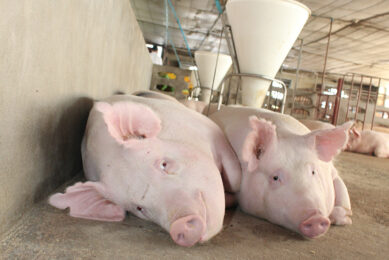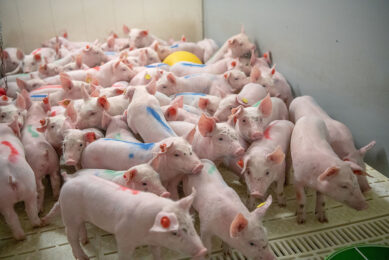Pigs and tigers: A unique combination
When visiting a tiger zoo in Thailand last month, I was surprised to bump into a more than familiar scene – a tigress in the same pen with little piglets. Her pictures are world-famous – but why keep pigs and tigers in one pen?
The Royal Bengali tigress is called Sai Mai and she has been living in Sri Racha Tiger Zoo, Chonburi province, since her birth in 2002. She is the only tigress in the zoo who is able to live and play with piglets, the PR office explained.
Sai Mai was born in captivity and breast-fed by a female pig for four months after her birth. That experience in her infancy has led her to regard pigs as family, not prey.
The zoo realises the combination is golden and puts piglets on display for the general public who come in masses and stare awestruck at the spectacle. Pictures go around the globe, as said.
The piglets themselves are fed by bottle or by a sow as they cannot drink with Sai Mai. Tiger teats are simply too large for them.
Cubs & a sow
Judging by the hits on the Web the reverse combination is far less photographed, but nevertheless it is the crux behind the species intermingling. Positioned next door to Sai Mai, behind a second window, a Landrace x Large White sow is lactating little tiger cubs together with piglets from her own litter.
This is done as the pigs seem to have a calming influence on the development of tiger cubs. A little sign on top said, “We have an experiment of letting the sow feed and look after the tiger cubs. As a result, the tiger cubs grow faster, are able to get along very well with the pigs and eventually they will become more tame and less fierce.”
Zoo officials said that the piglet feeding programme is part of an experiment that has been going on since 1997 now. Scientific trials have been carried out, although most information is kept confidential.
Zoo staff further said that usually about seven to ten tiger cubs are being brought to a sow for lactating purposes. They stay with her until the cubs are about two months of age – an average age for a tiger cub to be weaned – after which they will go to a ‘normal’ tiger feeding programme.
Both the amount of milk available to tiger cubs as the kind of milk could be making a difference. Sows can produce up to 10 kg of milk per day – which is most probably more than a tigress can. In addition, fat levels in tiger milk may also be lower than those of sow milk. Animals acustomed to live in a tropical climate usually do not develop as much, as fat is for protection against cold.
Judging by Sai Mai’s behaviour, it seems to be possible to thus make little tigers slightly more tame.
Web info
In an 1998 interview with press agency Reuters, zoo founder and Thai businessman Maitree Temsiriphong was quoted in an attempt to explain the zoo’s strategy, “When tigers drink pig milk, they think like pigs and so we can breed them easily.”
This sort of intermingling of species has become common at the Sri Racha Tiger Zoo, where ‘creating successful relationships with animals of different species’ is a guiding principle. Even dogs are sometimes included.
Since the zoo’s foundation in the nineties, it has come to house about 400 Bengal tigers, and has been breeding (and training) them successfully. Housing also many crocodiles and some elephants, the zoo hopes to contribute to the continuation of tiger presence in South East Asia, as tiger numbers have come down drastically.
Western views
Many Western activist websites, however, have their own look to this zoo in general and the use of pigs in particular. Some say this is heaven on earth with predators and prey sleeping side by side.
Many Western activist websites, however, have their own look to this zoo in general and the use of pigs in particular. Some say this is heaven on earth with predators and prey sleeping side by side.
Others, however, say it’s not possible as tigers would never get on with pigs like this unless they had been drugged or declawed and their teeth removed. (Doubtful as I felt nails when feeding the older cubs.)
In addition, many point their finger saying putting pigs and tigers together is just done for marketing purposes, to attract visitors. If that would be the case, I can only say one thing: Very well done!











